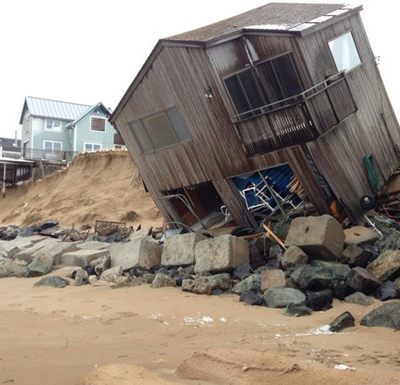It’s funny how the news can take you back to being 8 years old again.
This is the picture-of-the-day for the storm that’s hammered the East Coast today. It’s on Plum Island, a long spit of sand that runs along the north shore of Massachusetts, on the New Hampshire border.
The house, as you can imagine, is a goner. The people who own it are at their house in Florida and that’ll have to do. Their old house, and the land on which it once lay, belongs to the ocean again. (See some amazing pictures in this Facebook album)
That’s the way it works on Plum Island. And yet, people keep building as close to the ocean as they can.
Plum Island, which sits in the town of Newburyport, was a working-person’s enclave back in the day. Newburyport was a fishing and shoe-making town until the ’60s, when textile companies abandoned New England for the south. Now, it’s high-priced real estate for the wealthy.
I know that because when I was a kid, we had the oceanfront lot. We were the ’50s and ’60s pre-wealthy inhabitants.
Our home, though, wasn’t the multi-million dollar structure here or the type that, no doubt, are on either side of this home, awaiting their own fate. It was just an old trailer in which somehow, we fit seven people. When you were a kid on Plum Island back then, it wasn’t about your fancy house, it was about exploring what was around you. My parents would turn us loose in the morning and we might come back by dinner.
The Simmons family — he was a milkman — had the little cottage in front of us until the sea came calling and they moved it back a half mile or so to escape it. The Burkes had a little pink house across the sandy road, until they — and we — found it tipped upside down on the beach one spring. It had fallen into the path of an angry ocean and, apparently, nobody had noticed until it came time to open the cottage for the season.
That happened all the time. Like taking attendance at the beginning of class, we’d start each summer by determining what homes were no longer where they once stood.
The town tried everything to stop the ocean. Rocks, bigger jetties, old cars, truckload after truckload of sand, and for a time it seemed to work, but nature can be very patient. Even the sprawling Coast Guard station next door gave up and moved a little farther inland. In the end, you just can’t shovel sand against the tide.
We never got much of a chance to find out how our own plot would fare against it, though. A few years after the Simmonses moved their house, something else came calling — a man with money to make. He had offered my dad money for the land, but my parents wouldn’t sell. He loved the place and so did their five kids.
The next winter, someone took an axe to the trailer and, probably not coincidentally, the man called my father asking if he was interested in selling now. He was. And so a prime piece of beachfront property went for $5,000. I was too young to understand what a bitter pill that must’ve been for the old man.
A few weeks later, the trailer mysteriously burned down — the guy said he was working on the plumbing with a torch at the time — and in its place rose a multi-million dollar home, which as far as I know, still stands today.
The same thing happened up and down the beach. The old cottages gave way to the big homes, the working-class was mostly pushed out, leaving a generation of boys — now old — feeling only a little bit guilty and not at all proud of occasionally rooting for the sea.

